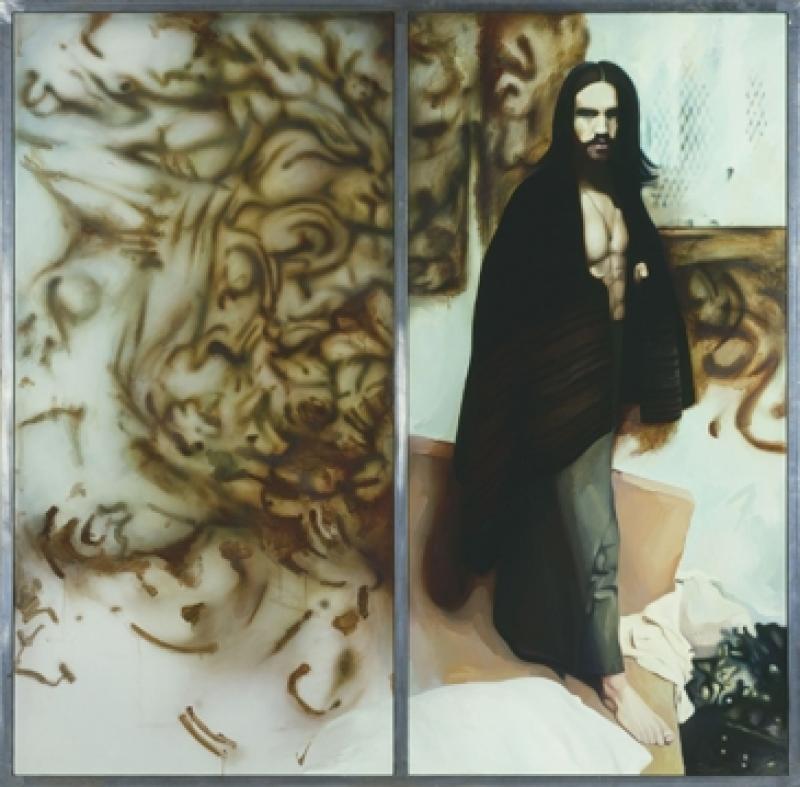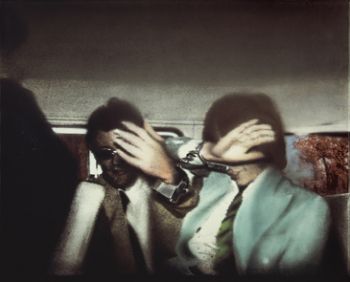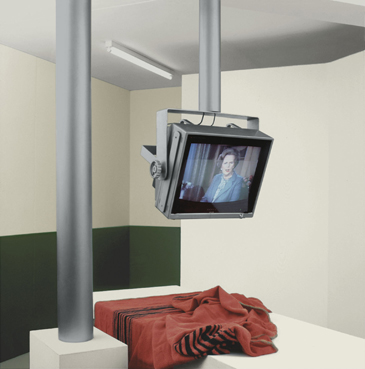Richard Hamilton: Modern Moral Matters, Serpentine Gallery | reviews, news & interviews
Richard Hamilton: Modern Moral Matters, Serpentine Gallery
Richard Hamilton: Modern Moral Matters, Serpentine Gallery
The medium is the message in Hamilton's body of political works

Richard Hamilton, the true father of Pop art and spiritual descendant of Duchamp, is not a particularly prolific artist. Rather, he sticks to an idea and works on it over several editions and in different media, so that we get a large body of work repeating the same image in paint, in collage, in photography and in mixed media.
 Modern Moral Matters, the title of the Serpentine Gallery’s survey of Hamilton’s small body of "political" works, is named after Hogarth. But Hamilton’s intelligence is too coolly detached to be deployed as satire. And, more crucially, since all his images are mediated through news sources, often we just don’t know what to make of Hamilton’s position: is he simply making a strident political point or merely commenting on how the media uses and manipulates images? You may come to the conclusion that it’s got to be both, but still, there is often room for some uncomfortable ambivalence.
Modern Moral Matters, the title of the Serpentine Gallery’s survey of Hamilton’s small body of "political" works, is named after Hogarth. But Hamilton’s intelligence is too coolly detached to be deployed as satire. And, more crucially, since all his images are mediated through news sources, often we just don’t know what to make of Hamilton’s position: is he simply making a strident political point or merely commenting on how the media uses and manipulates images? You may come to the conclusion that it’s got to be both, but still, there is often room for some uncomfortable ambivalence.
Take, for instance, his series of Northern Ireland paintings, the three large paintings, and their off-shoots, that come under the title of The Citizen (main picture above), The Subject and The State. These were produced over the course of a decade, beginning with The Citizen, a painting of IRA prisoner Bobby Sands, which Hamilton began shortly after Sand’s hunger-strike induced death in the Maze Prison. This diptych features one canvas daubed with swirls of brown paint, which can be appreciated as a bit of abstract expressionism, but of course refers to the period of "dirty protest" in the early Eighties when IRA prisoners draped themselves in blankets instead of wearing prison clothes, refused to wash, and smeared their excrement on to the walls of their cells. The other side features Sands himself, looking messianic: bare-footed, blanket-shawled, long-haired and bearded - Christ, but crossed with Charles Manson.
So what can we understand of Hamilton’s position from this troubling image? Is Sands a political martyr or a dangerous terrorist? Sands’s status as a charismatic figurehead is upheld, but so is the moral ambivalance of the liberal left. And is Hamilton mocking the liberal left position or supporting it? Or perhaps the ambivalence is merely this viewer’s projection, and Hamilton’s position is rather more trenchant. After all, the marching Orangeman in The Subject and the young squaddie in The State are not individualised personae who hold our attention half as much as the messianic Sands.
A less disconcerting body of work, but one even more suggestive of their times, is a series of images that Hamilton made in the late Sixties following the arrest, for the possession of cannabis, of Mick Jagger and art dealer Robert Fraser. Swingeing London (pictured above right) shows the two men handcuffed to each other and attempting to cover their faces as they are led away in a police van. This image is repeated over several works, though, unlike Warhol, in different media. And there’s also a collage featuring cut-out newspaper stories of Jagger’s appearance in court, with each story dwelling at length on Jagger’s literal appearance: the print shirt, the colour of his tie, the cut of his trousers. The image is the story, but while Hamilton highlights just what’s wrong with this kind of vapid news coverage, he also unambivalantly celebrates the power of the image. There are two works which begin and end this exhibition which, rather than beguile with their clever shifting subtleties, as Hamilton's best work can, irritate with their crassness. Treatment Room (pictured left), 1983-4, features a sterile-looking room, complete with a bed and TV screen. The TV is placed above the bed, just like at the dentist‘s: Thatcher is addressing the viewer/ patient, but the sound is turned down. Among other things, Hamilton is again making a point about the power of the image over content - though this work contains an element of agit-prop that makes the work, rather than Thatcher’s brand of harsh medicine, hard to swallow.
There are two works which begin and end this exhibition which, rather than beguile with their clever shifting subtleties, as Hamilton's best work can, irritate with their crassness. Treatment Room (pictured left), 1983-4, features a sterile-looking room, complete with a bed and TV screen. The TV is placed above the bed, just like at the dentist‘s: Thatcher is addressing the viewer/ patient, but the sound is turned down. Among other things, Hamilton is again making a point about the power of the image over content - though this work contains an element of agit-prop that makes the work, rather than Thatcher’s brand of harsh medicine, hard to swallow.
Even worse is Shock and Awe, 2007-08, in which a gun-toting Tony Blair is dressed as a cowboy against an exploding backdrop. It's a bit like Warhol’s Silver Elvis, though not half as appetising. In fact, it’s about as interesting, layered and subtle as reading a hundred protest placards bearing the word "Bliar".
- Richard Hamilton: Modern Moral Matters is at the Serpentine Gallery until 25 April
The future of Arts Journalism
You can stop theartsdesk.com closing!
We urgently need financing to survive. Our fundraising drive has thus far raised £49,000 but we need to reach £100,000 or we will be forced to close. Please contribute here: https://gofund.me/c3f6033d
And if you can forward this information to anyone who might assist, we’d be grateful.

Subscribe to theartsdesk.com
Thank you for continuing to read our work on theartsdesk.com. For unlimited access to every article in its entirety, including our archive of more than 15,000 pieces, we're asking for £5 per month or £40 per year. We feel it's a very good deal, and hope you do too.
To take a subscription now simply click here.
And if you're looking for that extra gift for a friend or family member, why not treat them to a theartsdesk.com gift subscription?
more Visual arts
 'We are bowled over!' Thank you for your messages of love and support
Much-appreciated words of commendation from readers and the cultural community
'We are bowled over!' Thank you for your messages of love and support
Much-appreciated words of commendation from readers and the cultural community
 Photo Oxford 2025 review - photography all over the town
At last, a UK festival that takes photography seriously
Photo Oxford 2025 review - photography all over the town
At last, a UK festival that takes photography seriously
![SEX MONEY RACE RELIGION [2016] by Gilbert and George. Installation shot of Gilbert & George 21ST CENTURY PICTURES Hayward Gallery](https://theartsdesk.com/sites/default/files/styles/thumbnail/public/mastimages/Gilbert%20%26%20George_%2021ST%20CENTURY%20PICTURES.%20SEX%20MONEY%20RACE%20RELIGION%20%5B2016%5D.%20Photo_%20Mark%20Blower.%20Courtesy%20of%20the%20Gilbert%20%26%20George%20and%20the%20Hayward%20Gallery._0.jpg?itok=7tVsLyR-) Gilbert & George, 21st Century Pictures, Hayward Gallery review - brash, bright and not so beautiful
The couple's coloured photomontages shout louder than ever, causing sensory overload
Gilbert & George, 21st Century Pictures, Hayward Gallery review - brash, bright and not so beautiful
The couple's coloured photomontages shout louder than ever, causing sensory overload
 Lee Miller, Tate Britain review - an extraordinary career that remains an enigma
Fashion photographer, artist or war reporter; will the real Lee Miller please step forward?
Lee Miller, Tate Britain review - an extraordinary career that remains an enigma
Fashion photographer, artist or war reporter; will the real Lee Miller please step forward?
 Kerry James Marshall: The Histories, Royal Academy review - a triumphant celebration of blackness
Room after room of glorious paintings
Kerry James Marshall: The Histories, Royal Academy review - a triumphant celebration of blackness
Room after room of glorious paintings
 Folkestone Triennial 2025 - landscape, seascape, art lovers' escape
Locally rooted festival brings home many but not all global concerns
Folkestone Triennial 2025 - landscape, seascape, art lovers' escape
Locally rooted festival brings home many but not all global concerns
 Sir Brian Clarke (1953-2025) - a personal tribute
Remembering an artist with a gift for the transcendent
Sir Brian Clarke (1953-2025) - a personal tribute
Remembering an artist with a gift for the transcendent
 Emily Kam Kngwarray, Tate Modern review - glimpses of another world
Pictures that are an affirmation of belonging
Emily Kam Kngwarray, Tate Modern review - glimpses of another world
Pictures that are an affirmation of belonging
 Kiefer / Van Gogh, Royal Academy review - a pairing of opposites
Small scale intensity meets large scale melodrama
Kiefer / Van Gogh, Royal Academy review - a pairing of opposites
Small scale intensity meets large scale melodrama
 Jenny Saville: The Anatomy of Painting, National Portrait Gallery review - a protégé losing her way
A brilliant painter in search of a worthwhile subject
Jenny Saville: The Anatomy of Painting, National Portrait Gallery review - a protégé losing her way
A brilliant painter in search of a worthwhile subject
 Abstract Erotic, Courtauld Gallery review - sculpture that is sensuous, funny and subversive
Testing the boundaries of good taste, and winning
Abstract Erotic, Courtauld Gallery review - sculpture that is sensuous, funny and subversive
Testing the boundaries of good taste, and winning
 Edward Burra, Tate Britain review - watercolour made mainstream
Social satire with a nasty bite
Edward Burra, Tate Britain review - watercolour made mainstream
Social satire with a nasty bite

Add comment